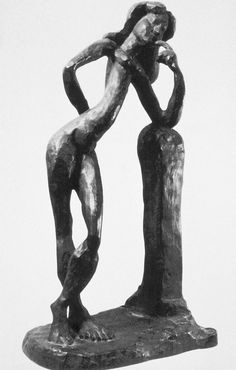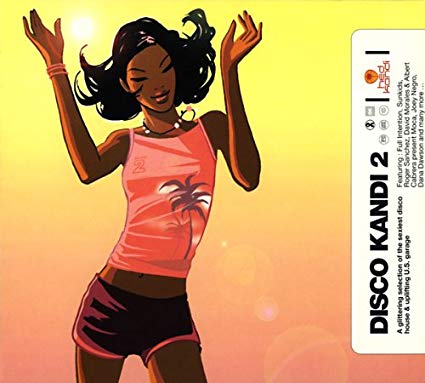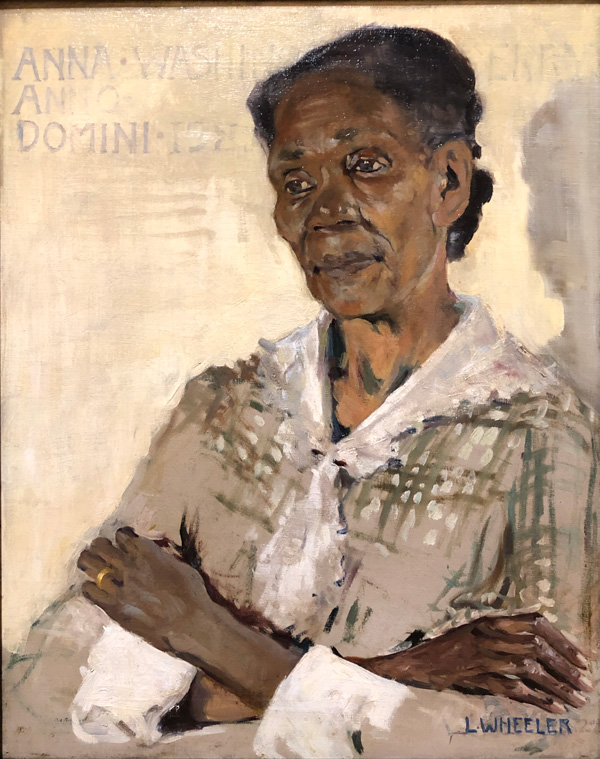Was Matisse’s La Serpentine a sister?

The question came to mind after I saw “Posing Modernity: The Black Model from Manet and Matisse to Today”—currently on view (through February 10th) uptown at Wallach Art Gallery. Matisse’s paintings and drawings figure in the exhibit along with two short videos of him painting black models. (More on those anon.) But the art of Matisse on view at the “Posing Modernity” exhibit isn’t as plainly sexualized as La Serpentine with her S’y essense, vaginangles and phallic leaning post. La Serpentine dates back to 1908. (Matisse did at least one other painting of a black nude around that time.) The images in “Posing Modernity” are from later in the century of the color line. By the 30s and 40s, Matisse may have been alive to a need for a new propriety when it came to white artists’ image-ing of black women. (His late 40’s note to one of his black models, thanking her for her “intelligent” poses as he was making drawings to accompany lines from Baudelaire, hints at his humane instinct to be on the mindful side of history.)
The fun of La Serpentine is pretty dickbrained, though it’s easy to imagine Matisse’s object of desire becoming her own subject. I can even scan you a picture on that score—this one is from the cover of a house music CD—put out by a UK record label whose packaging used to feature Serpentine sorts who never leaned on any man…

Not that the pop image above is entirely unencumbered by the weight of the past. When house music began crossing over around 1990, producers/marketers relied on videos where slim vixens stole the thunder of heavier soul singers who’d actually sung the songs. Black Box’s videos were notorious: “I Don’t Know Anybody Else” and “Everybody Everybody” quashed Martha Wash (formerly of “Two Tons of Fun”) and “Right on Time” erased Loleatta Holloway. There were other black model lip-synchers as well. The cover girl above may be a revenant of such substitutes. Back in the oughts, though, this image wasn’t so much a nod to horny guys (straight ones anyway) as an invocation of what’s now known as black girl magic. In my poor brain, the Ibizia clubber cum round-the-way-girl above seems more more in tune with Matisse’s floating spirits of The Dance than with pimpers/marketers. Her figure isn’t narrowcast for guys: she’s dancing for/with “everybody everybody” (and every black body).
My good faith here is founded on my own little history of musicking/dancing uptown. I’m flashing on a peak moment where I saw/heard sisterhood incarnate. It happened one “Diva Night” at the Apollo in the early to mid-90s. Sorry to be hazy about the date and I can’t find a record of the show, though I know my friend Charles O’Brien wrote it up for the Afro-American newspaper, The City Sun. I may have gotten a hint we were about to head out of recorded history into legend when Charlie and I waited for comps by the ticket booth. A Harlemite hovered next to us, asking about upcoming shows advertised on posters. I realized (eventually) he was posing what seemed like leading questions because he couldn’t read. He was surely a clever info-gatherer, but gaps in his knowledge showed when conversation turned to upcoming tours by performers scheduled to play the Apollo; he seemed to think Newark and Chicago were about the same distance from Harlem. And, on the mythic tip, who’s to say he was wrong?
Speaking of mythic, I doubt there was another time when so many heroines of house—which was basically an underground music—performed together. That night each singer seemed to get inspired by the others’ strengths. Those with the biggest voices also did beautiful detail work and ones who’d entered with daring subtleties (“la di dah, la da da”) proved they could get all up in the gutbucket. If memory serves, the divas were Wash, Holloway, CeCe Penniston, Adeva, Crystal Waters and perhaps one more. (Could’ve should’ve been Jocelyn Brown.) They were all stoked—no-one wanted to get shown-up. But there was a girls’ night out vibe that was kinda contra diva. Each vocalist ended up performing in concert with sister-singers in the crowd who turned the songs around. These more-than-fans were fantastic—the best audience I’ve ever been a (peripheral) part of. Their add-ons went beyond sing-alongs or even standard live-at-the-Apollo call-and-response. The crowd that night became a chorus, improvising collective riffs that lifted off from (or gave bottom to) high and sly notes hit on stage.
Together with their champions, that crowd made almost every song into an anthem of black womenism. Though black guys were more than welcome too. I remember Holloway gazing at (and goosing) one of her male go-go dancers and either her or Wash came back on stage after their own set to sing along with CeCe Penniston’s “Finally (It’s Happened to Me)”: “Meeting Mr. Right…with brown cocoa skin and curly black hair/just the way he looks at me that gentle loving stare.”
Nobody was gazing my way so I trust I didn’t stare at the woman with a La Serpentine aspect whom I saw on our way into the Apollo. She had the phrase “Sexy Girl” emblazoned on her pants, thigh high. Didn’t seem like a tease or a brand. More like a philosophical proposition. I knew I didn’t belong in the equation but she lives on in memory–a real ideal. One that got away? Nah, more like one born to be just out of reach…
xxx
“Posing Modernity” began with a reach. The curator, Denise Murrell, felt a need to find out more about the black servant in the background of Édouard Manet’s famous painting Olympia. Murrell sensed that woman of color was as undeniably modern as the unabashed white prostitute lying naked in the foreground. Olympia isn’t in the New York version of the exhibit[1], but its black woman, Laure, is there in a small portrait by Manet titled La Negresse.
Manet, the eternal modern, is always fresh, but La Negresse isn’t one of his essential works. And, in the absence of Olympia, the exhibit never really takes off, even if one sympathizes with the curator’s–and her colleagues’–aim to resist metaphorical takes on black women that mask “a human being or a lived reality.”
While the show’s paintings by Manet and his circle aren’t all that, the Matisses are gorgeous and there’s a nice yeasty quality to one of the short videos of him at work/play. His quick drawing, though, seems at odds with the show’s academicism. The curator allows Matisse was a jazz-lover, so where are the melodies? “Posing Modernity” is undercut by its eyes only approach and its Euro-first Fine Arts focus. This is not a high-low show or a black arts one (though it includes black painters). The gallery may be around the corner from 125th St. but it’s a world away from that walk of life where music used to soundtrack any crosstown trip–pouring out of every other store, oldies and goodies segueing into the next sound of young America. Not that 125th is what it once was when fools like me assumed you’d always be able to wander there, wondering at black solidarity and variousness.
Harlem is morphing into a place that might not be able to sustain that changing same. And that process isn’t beside the point when it comes to “Posing Modernity.” Wallach Gallery is part of a building complex just constructed on land grabbed by Columbia University, which prefers to define the local surround there as “Manhattanville” not West Harlem. My family and neighbors fought for years against Columbia’s expansion, which displaced businesses and friends. While University powers-that-be probably regard “Posing Modernity” as a gesture to the community, critic Tiana Reid has noted “it’s hard not to read its content in the context of the building in which it’s housed”:
The relationship between a successful painter and their figure model is like the relationship between Columbia’s campus and Harlem’s streets. One is endowed with expertise, glory, and the possibility of capital accumulation, and the other is an expropriated muse but in effect the locus where culture resides. One haunts the other.
I had the haints when I exited Wallach Gallery, heading across the flat plaza toward the spot where the old Floradita restaurant once stood con 60 cent expressos and tasty Afro-Latin music that amped you up even more than the caffeine. Thinking over the exhibit, I homed in on Charles Keil’s aphorisms about civilization and (pre-Columbia?) culture.
Civilization is the crap that culture leaves behind.
Civilization, as a whole, piles up; culture gets smothered.
Being more civilized means having more museums and libraries; culture is giving yourself to prime and present time.
Conversation is culture; writing is civilized…
Maybe that’s why I never got too far into the memoir I tried to write in the 90s about my life as a black music lover. My intro relied too much on racecraft, but it’s not entirely out of time (though the references are dated)…
I’m no homie but I’m almost at home in black Atlantic spaces. I’ve pitched my tent on the edge of the race. And often I’m a happy camper. On the edge of the race is a metaphor, partly. I live one long block from 125th St. But place isn’t everything. Listening is what counts. That’s what I do. I listen in. To music of the inner city, to voices of women who take me seriously (what else could they be but black?), to players and race men, to street girls and church girls (and Da Brats who are both), to Bro Man and brothers on the block and ones who are like family. When I’m sure I’ve heard something and know what it is, I write it up for an Afro-American paper, The City Sun. I have a taste for and some expertise in black pop music. I’m a specialist half-caste. Only in New York, kids, only in New York? Nope, there’s no money in this deal. I’m not working a skin game. I try to hear through America’s racial spectacles…
I was going to call my song book “Hear in the City.” But Charlie O’Brien, witness to my wack love-life, proposed another title: “Black Woman’s Burden.” The joke was on me of course. But true wit has many uses. O’Brien’s phrase came to me when I took a second look at a painting I’d passed by blankly on my first visit to “Posing Modernity.” What’s weighing on the woman in the portrait below, though, isn’t the stuff of comedy.

It was Tiana Reid’s criticism that helped me see this painting by Harlem Renaissance-era painter Laura Wheeler Whiting with new eyes. While Reid was unenthralled by “Posing Modernity,” she gave Whiting and her subject, Anna Washington Derry, respect.
She appears to be, like many black women before and after her, just a little fed up. But she showed up nonetheless. She’s looking resolutely somewhere but not at us. The “buts” that flock the very idea of portraiture — its desire to shore up a digestible subject — are present here. A criss-crossed blouse and pulled-back hair serves as armor, flexible texture against a hard-edged world. But in all the life she’s lived, the life you can see in her wise gaze, there’s softness there.
And a shadow. For those of us looking, for those of us with the will to look, black women’s figures pervade modern art — like Laura Wheeler Waring’s shadow, a kind of absent presence that provides the feel or the grit to aesthetic representation.
Hope Ms. Reid never loses her will to look. American culture and civilization need her vision.
Note
1. Olympia will be in the next European iteration of the exhibit.